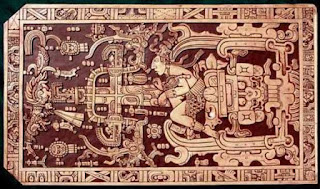The stone Sarcophagus lid of
King Pacal produced considerable controversial theories, one is Mainstream
scholars believe that the inscriptions says about King Pacal on a journey to
the underworld, but ancient astronaut theorists believe that the king is portrayed
at the seat of the controls of a space craft and have dubbed him the Palenque
astronaut.
King K'inich Janaab' Pakal
also known as Pacal was the Maya king of Palenque (today- Mexico). He was most famous for raising the city of
Palenque from relative obscurity to a great power, his building projects in the
city (especially the Temple of the Inscriptions), and his elaborately carved
sarcophagus lid which has been interpreted as an ancient astronaut riding on a
rocket ship. Pacal assumed the throne of Palenque at the age of 12, in 615 CE,
and ruled successfully until his death at the age of 80.
Pacal was the son of Lady
Sak K'uk who reigned as Queen of Palenque from 612-615 CE. She ruled for three
years until her son reached maturity which, at that time, was the age of 12.
Pacal almost instantly began building enormous and elaborately worked monuments
in order to celebrate both the city's past and his family's legitimate claim to
rule.
Temple of the Inscriptions:
Temple of the Inscriptions
pyramid was constructed in 675 CE and it was built as the tomb of Pacal. The
Temple of the Inscriptions is a pyramid with a small building at the top
inscribed with the second longest continuous Mayan text yet uncovered in
Mesoamerica.
Discovery:
For a century after Palenque
was discovered, the pyramid was thought to be a religious centre in the city
(as the inscriptions were undecipherable) until the Mexican Archaeologist
Alberto Ruiz recognized that the walls of the small temple continued down below
the floor. He discovered that the platform of the floor had drill holes, which
had been sealed by stone plugs, and surmised that the Maya had lowered the
floor into place with ropes, perhaps, to seal a royal tomb. Between 1948 and
1952 CE, Ruiz worked with his team, excavating the temple and, finally,
discovered the tomb of Pacal the Great. He shone his flashlight down into the
tomb.
Whatever he seen, he writes
like this-
"Out of the dim shadows emerged a vision from a fairy tale, a fantastic, ethereal sight from another world. It seemed a huge magic grotto carved out of ice, the walls sparkling and glistening like snow crystals. Delicate festoons of stalactites hung like tassels of a curtain, and the stalagmites on the floor looked like drippings from a great candle. The impression, in fact, was that of an abandoned chapel. Across the walls marched stucco figures in low relief. Then my eyes sought the floor. This was almost entirely filled with a great carved stone slab, in perfect condition."
Pacal’s Sarcophagus:
The Sarcophagus' lid
measures 3.6x2 metres (12x7 feet) and shows king Pacal sitting in some kind of
spacecraft. He is at an angle like modern-day astronauts upon lift-off. He is
manipulating some controls. He has some type of breathing apparatus or some
type of a telescope in front of his face. His feet are on some type of a pedal.
And you have something that looks like an exhaust with flames.
His upper hand is
manipulating some controls. From the lower hand, he is turning something on. The heel of his
left foot is on a kind of pedal and, outside the capsule, you see a linking
flame. This is incredible. This is absolute proof of extraterrestrials.
The most famous symbol in
this picture is that of the “World Tree”- Shows a man tilting backwards at the
base of a tree, with a bird high at the top, either falling into or springing
out of what appears to be a large urn. Glyphs and symbols run around the edges
of the lid, all representing important components of Mayan cosmology.
The World Tree, which the
Maya believed had its roots in the underworld, trunk on the earthly plane, and
branches high in paradise, and Pacal's relationship to it in death. The king is
depicted either at the moment of his death falling from the earthly plane down
into Xibalba or at the moment of his resurrection from the underworld, climbing
up the World Tree toward paradise. The adornments along the edges represent the
sky and other glyphs the sun and moon and, still others, past rulers of
Palenque and Pacal's place among them. The bird at the top of the tree is the
Bird of Heaven (also known as The Celestial Bird or Principal Bird Deity) who represents
the realm of the gods in this piece, and the `urn' beneath Pacal is the
entrance to Xibalba.
The celestial bird
represented the heavens and thus was pictured on the top of the World Tree.
Roots of the World Tree extending into the underworld which is not just typical
for depictions of the World Tree, it’s pretty much a requirement.In the
underworld we see a picture of the Mayan sun monster which Pacal is riding into
the underworld. So Pacal is hitching a ride on the sun into the underworld.
In Mayan art whenever you
see a so-called “traveler”- which is a person in transition from one world to
the next – there must be something that is making that travel possible.
Sometimes it is a twisted umbilical cord, but almost always it is a serpent,
often a double headed serpent. In other words being in the mouths of a double
headed serpent was a symbol of transition from one world to the next. You can
see that the so called smoke is actually the traditional serpent’s beard which
appears in almost every depiction of a serpent in Mayan art.







0 Comments